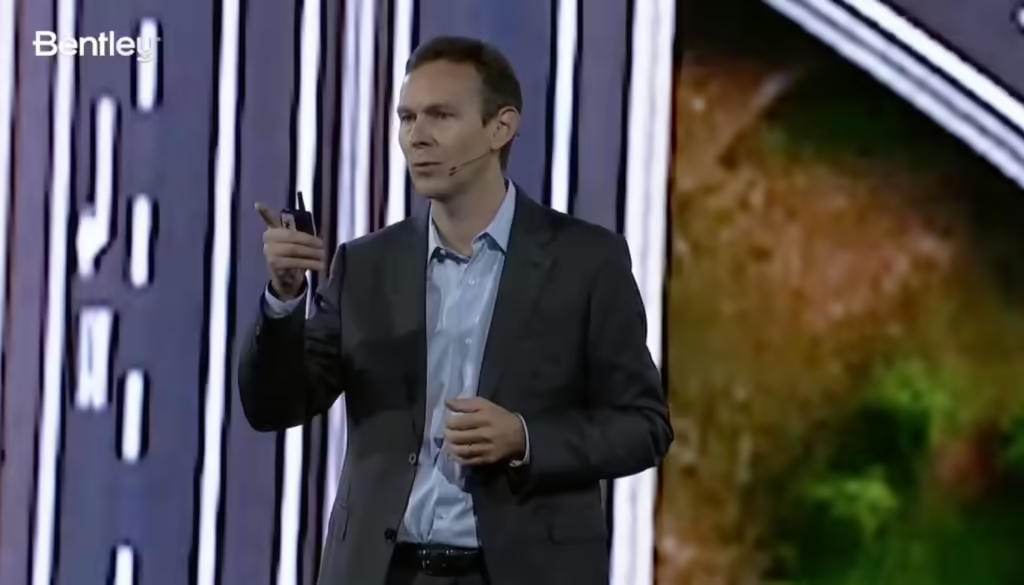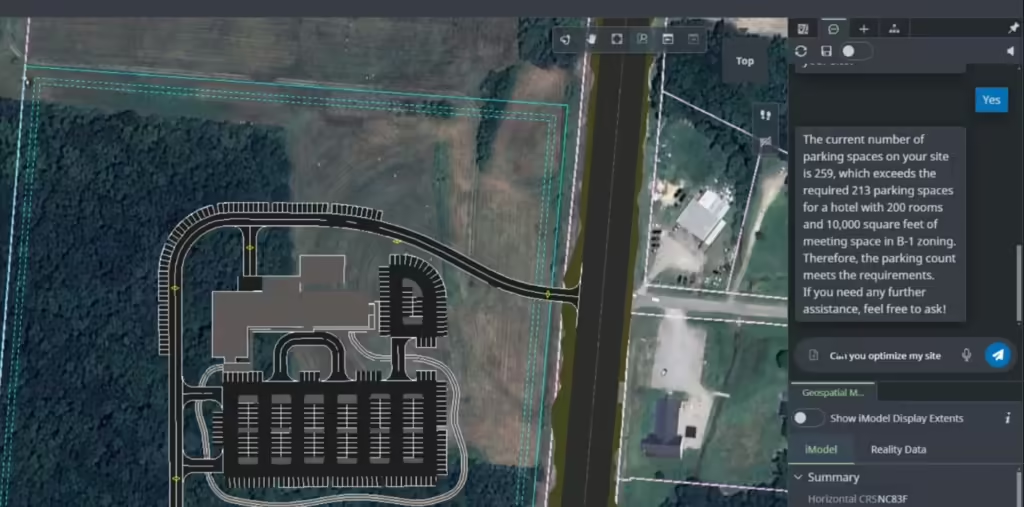At just about every industry conference of late, the subject of AI has dominated the conversation. It was no different at Bentley Systems’ Year in Infrastructure event earlier this month, as CEO Nicholas Cumins discussed how the technology is revolutionizing the AECO industry and creating a new paradigm shift. He also detailed how Bentley is harnessing and expanding the power of AI to enable its users to be more productive. The AECO industry produces a plethora of data but uses only a small percentage of that. AI can help make that data more useful, and a key element of that is an open platform, he said. Bentley also used the event to introduce two new AI-powered offerings: a new product portfolio called Bentley Asset Analytics, which leverages AI to generate insights into the operating conditions of existing infrastructure assets, and OpenSite+, a new engineering application for civil site design that features generative AI capabilities.
It’s no secret that the AECO industry is on the cusp of a new paradigm shift. During Bentley Systems’ Year in Infrastructure 2024 event earlier this month in Vancouver, CEO Nicholas Cumins, who recently took over that position from long-serving Greg Bentley, told conference-goers that the next transformative technology is, of course, artificial intelligence. And Bentley is ready for this transformation, having invested in AI for years, he said.
Embracing technology to drive transformative change has been the foundation on which the company was built and the building blocks that has enabled it to grow over the years, starting when Keith Bentley founded the company, envisioning the PC as a way to make CAD software more accessible.
“Bentley gave engineers the tools to help them work more efficiently, more precisely, forever changing the way infrastructure was designed. And as the technology evolved, so did our approach to design,” said Cumins.
The move from 2D to 3D enabled engineers to visualize their projects in more realistic ways and solve problems before construction began. The Internet changed the way assets are managed through improved coordination with everyone working from the same accurate information in real time. Then came the fourth dimension, with 4D construction modeling for tracking progress from beginning to end through digital twins and dynamic replicas of infrastructure assets that are continuously updated with real-world data. And now, there’s artificial intelligence, which is transforming every industry, and infrastructure is no exception.
The sheer scale of data that is generated during the design, construction, and operation phases of a project is immense, making infrastructure a prime area where AI can have substantial impact. Already, engineers and contractors are using machine learning and AI to help them anticipate and address problems before they arise. Yet, this is just the tip of the iceberg. AI has a huge potential in the design phase of the infrastructure life cycle. As Cumins noted, it can automate repetitive tasks such as documentation or annotations, to free up engineers so they can focus on higher-value activities. AI can also act as a copilot, suggesting refinements to make designs more effective, more carbon efficient, and better suited for the challenges that lie ahead. At the end of the day, AI’s true power will be measured by its ability to improve outcomes, Cumins said, with more sustainable designs, faster and safer builds, and more reliable infrastructure systems.
“As we look to the future, the possibilities seem endless, but to begin to understand what’s possible tomorrow, we need to be clear on the state of the industry today, and infrastructure today is facing unprecedented challenges around the world,” Cumins said.
For example, demand for better, more resilient infrastructure is surging, whether it’s to expand the energy grids, to modernize transportation networks, or to retrofit existing structures to meet the sustainable development goals. There’s also a growing shortage of a skilled workforce to meet those demands.
What is not in short supply, however, is data. And therein lies the biggest paradox of this industry, according to Cumins. There is so much data but comparatively so few insights—only a small fraction of the data generated is ever analyzed. He said some analysts estimate that at best, only 10% of the data collected is used. But to take advantage of AI and other innovations, companies need to take control of their data and optimize the infrastructure they already have in place, he added.

The future of infrastructure engineering and the key to making all that data accessible is through open data ecosystems, Cumins said. Because infrastructure projects are complex, involving multiple organizations, teams, disciplines, and stakeholders, infrastructure organizations need an open ecosystem for their data that enables integration and interoperability across different tools and platforms. Open data ecosystems make data accessible, including for AI. This is important, Cumins explained, because infrastructure sectors create massive amounts of data during design, construction, and operations. By applying AI, infrastructure data can be analyzed for deeper insights.
It’s worth noting that Bentley’s iTwin is an open platform for infrastructure digital twins, built on open APIs. For example, Bentley’s iTwin solutions apply AI to improve infrastructure operations, allowing engineers to monitor, manage, and optimize assets, while AI agents analyze digital twins to identify maintenance issues and recommend preventive action, avoiding costly breakdowns or safety hazards.
“We’re laying the groundwork for a future where open data ecosystems and AI work seamlessly to create more sustainable and resilient infrastructure, for better quality of life, for generations to come,” said Cumins.
With that in mind, Bentley is combining existing products and solutions, new innovations, and acquisitions into a new product portfolio called Bentley Asset Analytics, which leverages AI to generate insights into the operating conditions of existing infrastructure assets. With AI-powered Asset Analytics, users can digitally capture real-world insights to reduce manual workloads and streamline decision-making.
The portfolio includes Blyncsy, which automates roadway maintenance and asset inventory activities through crowd-sourced imagery and AI, and OpenTower iQ, which automates every stage of the telecommunications tower life cycle through drone-captured imagery, other data sources, and AI. Bentley said it plans to cover a wide range of asset classes and incorporate diverse data-capture techniques, such as IoT sensors and drones, to create solutions for owner-operators.
According to Cumins, the true power of Asset Analytics surfaces when integrated into a digital twin, which pulls together data from various sources to create a clear and evolving picture. He said the company invites engineering firms to partner with Bentley on this, as delivering on the promise of AI-driven asset analytics requires close collaboration.

While AI is already playing a crucial role in assessing infrastructure, its potential extends even further, into the design phase of the infrastructure life cycle. Infrastructure organizations can leverage AI and reuse their data to automate repetitive tasks, such as documentation and annotation, enabling engineers to focus on higher-value activities. To this end, at the Year in Infrastructure conference, Bentley announced OpenSite+, a new engineering application for civil site design that features generative AI capabilities. The software comes equipped with an AI-driven copilot, automated drawing production capabilities, and site layout and grading optimization tools that allow users to evaluate multiple design alternatives for residential, commercial, and industrial sites.
OpenSite+, a digital twin-native product built with Bentley’s iTwin platform, combines design and routine tasks on one platform. It creates site designs up to 10 times faster than using traditional methods and with greater accuracy, according to Bentley. One key feature is the software’s ability to generate smart objects, which understand their context and can adapt to design changes. In OpenSite+, elements know what they are—a parking lot, building pad, driveway, storm drainage, etc.

OpenSite+ is the first of a new generation of Bentley Open Applications that run on desktops for optimal responsiveness, while offering the benefits of cloud-based applications, such as automatic updates and cross-operating system availability.
North American site engineering firms can apply for early access to OpenSite+.
“At the end of the day, AI’s true power will be measured by its ability to improve outcomes—more sustainable designs, faster and safer builds, and more reliable infrastructure systems. As we look to the future, the possibilities seem endless,” Cumins said.






